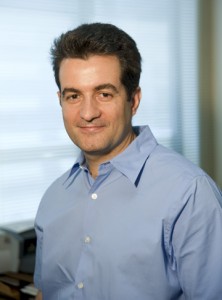Category: Research
SE/ECE/CS Team Wins $1M NSF Grant with UMass and UConn for “Smart City” Research
A team of faculty led by Christos Cassandras (SE-ECE, Head of SE Division) with Yannis Paschalidis (SE-ECE, Co-Director of CISE), Azer Bestavros (CS) and Assaf Kfoury (SE-CS) has won a major new NSF grant to support their research project: A Cyber-Physical Infrastructure for the Smart City.

The project aims at making cities “smarter” by engineering processes such as traffic control, efficient parking services, and new urban activities such as recharging electric vehicles. To that end, the research will study the components needed to establish a Cyber-Physical Infrastructure for urban environments and address fundamental problems that involve data collection, resource allocation, real-time decision making, safety, and security. Accordingly, the research is organized along two main directions: (i) sensing and data acquisition using a new mobile sensor network paradigm designed for urban environments; and (ii) decision support for the “Smart City” relying on formal verification and certification methods coupled with innovative dynamic optimization techniques used for decision making and resource allocation. The work will bring together and build upon methodological advances in optimization under uncertainty, computer simulation, discrete event and hybrid systems, control and games, system security, and formal verification and safety.
Target applications include: a “Smart Parking” system where parking spaces are optimally assigned and reserved, and vehicular traffic regulation. The research has the potential of revolutionizing the way cities are viewed: from a passive living and working environment to a highly dynamic one with new ways to deal with transportation, energy, and safety. Teaming up with stakeholders in the Boston Back Bay neighborhood, the City of Boston, and private industry, the research team expects to establish new collaborative models between universities and urban groups for cutting-edge research embedded in the deployment of an exciting technological, economic, and sociological development.
This is a collaborative research project with UMass and UConn. The investigators outside BU include: Weibo Gong (UMass Amherst) and Robert Gao (UConn). The award totals $1M ($700K to BU + $150K to UMass + $150K to UConn). Congratulations to the whole team!
New Research Could Help Trace Source of Bioterror Agents
By Mark Dwortzan
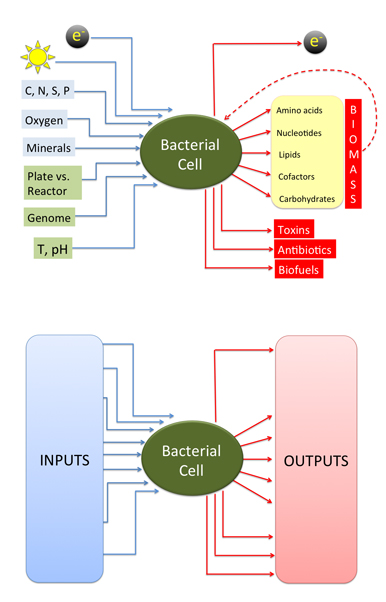
A bacterial cell receives several inputs from its environment, including the availability of different nutrients and the ambient temperature and pH. Based on these inputs, a bacterium controls its growth rate and molecular composition, which can be thought of as the output of the system. By combining experimental measurements and mathematical models, Paschalidis and Segre aim to gradually dcode this input-output relationship and thereby predict the output given the input or vice versa, enabling researchers to track the source of potential pathogens.
Through genetic manipulation or growth in the laboratory, microbes can be engineered for either harmful aims, such as anonymous anthrax attacks, or beneficial purposes, such as vaccines, fuel cells or pollution control systems. A better understanding of how the conditions in which a bacterial cell is grown impact its metabolism and biochemical composition could lead to new tools to help counter potential bioterror threats and advance the development of a wide range of peaceful applications.
Now an interdisciplinary team of systems engineers, computer scientists, microbiologists and biochemists—including Boston University researchers (Professor Yannis Paschalidis (ECE, SE) and Associate Professor Daniel Segrè (Biology, BME, Bioinformatics), as well as the University of Texas and Harvard University—seeks to establish clear links between bacterial cells’ growth conditions and their resulting composition by developing and testing advanced mathematical methods. Funded by a $7.5 million grant from the U.S. Army Research Office, the five-year project could lead to new ways to track the source of a bacterial pathogen, and to help discriminate between natural infectious outbreaks and the deliberate spread of pathogens.
Bacterial cells are typically grown in a nutrient-rich broth containing all the raw materials they need to grow and multiply. The growth medium and environmental factors particular to a lab, such as temperature or pH, constitute the growth conditions that collectively influence the metabolism and biochemical composition of a microorganism. To draw links between a bacterial cell’s growth conditions and its current composition, the researchers plan to model the cell as a system with inputs (growth conditions) and outputs (cell composition), and devise a functional mapping, or mathematical formulas, that transform inputs to outputs and vice versa.
Paschalidis plans to apply optimization techniques to produce these mappings.
“If we observe the cell composition, what can we say about the environment and growth factors impacting that composition?” he says. “The challenge in identifying the source of a bioterror attack is to solve this problem and infer the input from the output.”
Segrè, an expert in the use of mathematical models to drive biological discovery, will develop computer simulations of microbial metabolism and growth under a wide range of possible laboratory conditions. Based on these simulations and experimental measurements to validate their accuracy, Paschalidis will infer how various growth conditions impact the composition of a bacterial cell.
“The composition of the microbial cell may carry information on where it grew and how it evolved, like a hidden signature, that we will try to characterize and interpret,” Segrè observed. “If a bacterium grew under unusual circumstances, or was artificially evolved in a lab, this will likely be reflected in the cell composition.”
Cyber-Security Research
By Rachel Harrington
As people grow more dependent on computers for everything from accessing their bank accounts to storing sensitive information, cyber security has become an increasingly important research area.
At Boston University, Professor Ioannis Paschalidis (ECE) is hoping to improve upon computer data protection by developing an effective way to detect intrusions into private networks and any exfiltration of sensitive or classified information.
“Cyber attacks not only can compromise classified information – whether military, government, or corporate – but also cripple the nation’s key infrastructure – including financial institutions, telecommunications, air-traffic control, and the electricity grid,” said Paschalidis. “Being able to detect such attacks is an important first step to effective counter-measures.”
The U.S. Army Research Office seemed to agree with his sentiments recently when they awarded $600,000 to his project, “A Coordinated Approach to Cyber-Situation Awareness Based on Traffic Anomaly Detection.”
Paschalidis, the principal investigator (PI) on the project, will work closely with Co-PIs, BU professors, Christos Cassandras (ECE) and Mark Crovella (CS), and Paul Barford from the University of Wisconsin.
The team aims to build upon their previous research in order to develop a series of anomaly detection algorithms and tools that will monitor network traffic and operate at both local and global levels. To improve counteraction, input will be processed by a clustering/pattern recognition approach that will identify and classify specific cyber attack scenarios.
Looking forward to partnering with the Army Research Office, Paschalidis said, “This collaboration will provide us with real examples of attacks we can leverage to improve our methods.”
Flight Lessons From Bats, Birds and Insects
ENG Faculty, Alum Partner in $7.5M Grant to Develop Bio-Inspired Aerial Vehicles
By Mark Dwortzan
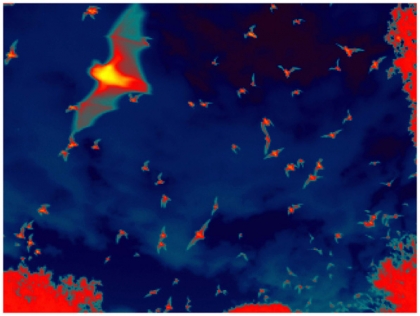
High-resolution thermal image of bats in flight. Such images will be used to develop flight control algorithms approximating bat flight. (Image courtesy of Tom Kunz, BU professor of biology)
Can studying the flight dynamics of bats, birds and insects lead to a new generation of unmanned aerial vehicles that can navigate more effectively in cluttered environments? To maneuver as well as winged animals in tight places such as forests and caves, and land as safely on variable and moving terrain, an engineered system would have to incorporate unprecedented sensing and control capabilities while satisfying complex physical design, weight and computational requirements.
Aiming to build a process for translating biological capabilities for agile flight in a range of environments for engineered flight vehicles, the Office of Naval Research (ONR) has awarded a five-year, $7.5 million grant to a team of researchers from Boston University, the University of Washington, the University of Maryland and the University of North Carolina at Chapel Hill.
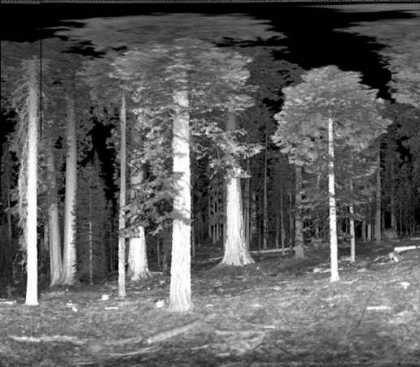
Computer reconstruction of a 3-D Lidar image. Images of actual animal habitats will be used to reconstruct animal flight paths through the imaged habitats. (Image courtesy of Xiaoyuan Yang, a graduate student in the BU Department of Geography and Environment.)
Operating under a $3.1 million subcontract, the Boston University team includes Professors John Baillieul (ME) and Ioannis Paschalidis (ECE) and Assistant Professor Calin Belta (ME) in the College of Engineering; and Thomas Kunz, professor of biology, and Margrit Betke, associate professor of computer science, in the College of Arts & Sciences. The project’s principal investigator, Kristi Morgansen, associate professor of aeronautics and astronautics at the University of Washington, received her B.S. and M.S. degrees in mechanical engineering from Boston University in the mid-1990s.
Combining expertise in birds, bats and insect flight as well as in sensor and control systems, the researchers will study the dynamics of winged creatures on a neurological level, in the laboratory and in free flight. By carefully examining how diverse airborne species sense their environment in forests, caves and other cluttered spaces and use that data to control their movement, they could help engineers design more agile unmanned aircraft for military, disaster recovery and other applications.
Entitled AIRFOILS (Animal Inspired Flight with Outer and Inner Loop Strategies), the project seeks to develop techniques to balance long-range goals, such as reaching a final destination, with short-term navigation, such as avoiding obstacles or sustaining wind gusts.
“We will try to learn how these animals move from place to place and react to obstacles, and rethink flight control algorithms from the ground up,” said Belta. “Classical flight control algorithms emphasize stability and safety, but it may be advantageous to modify these algorithms so vehicles can react quickly to the environment.”
In one scenario, biologist Thomas Kunz will image bats flying through forests with high-speed, high-resolution, thermal cameras; computer scientist Margrit Betke will convert Kunz’ raw image data into a three-dimensional computer model of bat trajectories through a forest; and Baillieul, Belta and Paschalidis will use the computer-reconstructed bat trajectories to develop flight control algorithms that approximate the bat flight, and ultimately test them on real vehicles.
Recognizing that bats and other winged creatures often fly in formation, the College of Engineering team’s work will leverage their previous research on multiple robot formation control and feedback control of mobile vehicles.
“We’ve worked with ground-based robots and operated them in formation,” said Bailleiul. “The goal is to take what we know about controlling groups of mobile robots and apply it to aerial vehicles that must rapidly maneuver through clutter.”
A former student of Bailleiul’s who became an expert in the control of aerial and underwater vehicles, Morgansen has built robotic fish and studied how schools of fish navigate underwater. For AIRFOILS, she is expected to develop sensors to place on the flying vehicles that mimic the many simple sensors used by bats and other winged animals to gather critical information about their environment.
AIRFOILS is funded through the ONR’s Multidisciplinary University Research Initiative (MURI) program, which supports fundamental research with the potential for commercial and defense applications.
Research Focuses on Getting Wireless Networks to Fix Themselves
By Jason L London
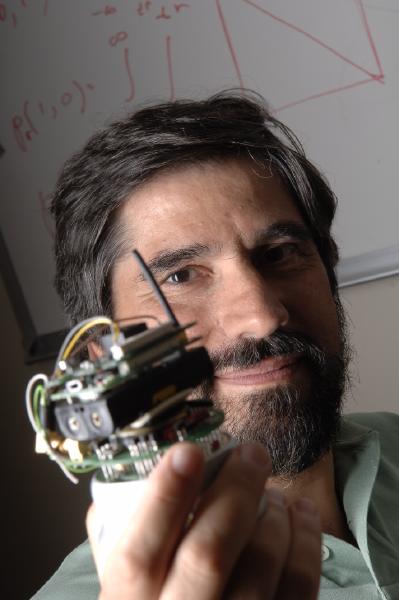
Professor Christos Cassandras is the principle investigator on a four-year, $2 million National Science Foundation grant to advance the reconfiguration of autonomous networks. The main test bed for this research will be OpenAir Boston, a private, non-profit organization that will oversee the impending wireless network over the city of Boston.
Professor Christos Cassandras is the principle investigator on a four-year, $2 million National Science Foundation grant to advance the reconfiguration of autonomous networks. The main test bed for this research will be OpenAir Boston, a private, non-profit organization that will oversee the impending wireless network over the city of Boston.
Professor Christos Cassandras is the principle investigator on a four-year, $2 million National Science Foundation grant to advance the reconfiguration of autonomous networks. The main test bed for this research will be OpenAir Boston, a private, non-profit organization that will oversee the impending wireless network over the city of Boston.
The National Science Foundation has awarded Boston University Professor Christos Cassandras (MFG), Associate Professor Ioannis Paschalidis (MFG) and CAS Computer Science Professor Azer Bestavros a four-year, $2 million Emerging Frontiers in Research and Innovation (EFRI) grant to advance the reconfiguration of autonomous networks in the wake of an unexpected problem or system error. The grant, Cassandras said, will be used to develop software that will allow a network to reset itself after an unexpected technical problem or sudden changes in operating conditions. The main test bed for this research will be OpenAir Boston, a private, non-profit organization that will oversee the impending wireless network over the city of Boston.
The project’s research aims to create a fundamental understanding of system reconfigurability.
“This research project is innovative and an excellent complement to our objectives,” Pamela Reeve, chief executive officer of OpenAir Boston, said. “The proposed research will play a crucial role in reaching the goal of a responsive enterprise able to adjust to changing conditions.”
Additional research will be done by placing sensor nodes on trucks inside the warehouse of the Raymond Corp., one of North America’s largest manufacturers and suppliers of electric lift trucks.
“The goal is to develop a network that has the ability to automatically reconfigure itself,” Cassandras, the project’s principal investigator, said. “If a transceiver breaks down, a battery runs out or something fails because of weather, the network will have the capability to reconfigure itself and continue supporting its mission without anyone physically having to correct the problem.”
The opportunity to apply this research to a major urban environment like Boston impressed the National Science Foundation, Cassandras said.
“The fact that we had a test bed over the city of Boston was a unique idea,” he said. “The idea itself is certainly different and ambitious, as is the collaborate effort of Boston University and a private industry like OpenAir Boston.”
Because the OpenAir Boston system will initially incorporate only basic capabilities of a wireless network, the grant will allow the network to add a reconfigurability feature that will incorporate extra intelligence otherwise difficult to do when the wireless network is fully operational.
“This will help make the design robust from the beginning,” Cassandras said. “To retroactively impart extra data to any system is difficult. This will allow us a much better chance of success.”
Much of the grant’s research will be conducted by the Center for Information and Systems Engineering (CISE), a systems engineering collaboration between faculty from the College of Engineering, the College of Arts and Sciences, and the School of Management. CISE will be the main point of collaboration between Boston University and OpenAir Boston. Two professors from the University of Massachusetts will also collaborate on the grant.
“This grant is another success story for CISE,” Cassandras said. “Our hope is that Boston University and CISE become the heart soul of the wireless network in Boston.”
ENG faculty developing sensors that stay in touch
By Tim Stoddard
 |
|
| John Baillieul, Christos Cassandras, and Yannis Paschalidis (seated, from left) of ENG’s Center for Information Systems Engineering are developing sensor network control systems with far-reaching applications in manufacturing, homeland security, and space exploration. Their interdisciplinary team includes University of Massachusetts, Amherst, faculty Abhi Deshmukh, Weibo Gong (standing, from left), and Robert Gao (seated, far right). Photo by Fred Sway | |
When an unbalanced washing machine starts dancing across the floor, a sensor inside detects the wild gyrations and halts the spin cycle. In the future, says Christos Cassandras, washing machines and other household appliances will go a step further: they’ll call a repairman before a part breaks.
Cassandras, an ENG professor of manufacturing engineering, says that appliances will be only one of many applications for so-called sensor networks, which feature a constellation of miniature devices that monitor a wide range of things, from vibrations to temperature to toxic chemicals and biological weapons. Cheap, lightweight, and built with tiny radios, the sensors will talk to one another, coordinating their reconnaissance and relaying their findings to a distant computer. An aging washing machine, for example, might notify the manufacturer of an imminent problem over a wireless Internet connection. The owner might then receive an e-mail from the dealer to schedule a service visit for a part that may not break for several weeks.
Sensor networks promise to improve everything from manufacturing to homeland security to endangered species management. But while the technology for building tiny, cheap, and intelligent sensors is rapidly emerging, Cassandras says, the challenge now is to develop theories for managing the flow of information among hundreds or even thousands of networked sensors. With an interdisciplinary team of engineers at ENG’s Center for Information Systems Engineering (CISE), Cassandras and his colleagues have received a prestigious award from the National Science Foundation’s Division of Design, Manufacturing, and Industrial Innovation to develop methods of managing complex sensor networks.
With the award’s $2.5 million over the next five years, the BU team will work with colleagues at the University of Massachusetts, Amherst, to design sensors that communicate with one another, learn on the job, and tolerate extreme environments. The team includes Yannis Paschalidis, an ENG associate professor of manufacturing engineering, David Castañon, an ENG professor of electrical and computer engineering, and John Baillieul, an ENG professor and chair of the department of aerospace and mechanical engineering.
Initially, the CISE team will go to the chalkboard, hashing out the theories and principles underlying sensor networks. “We’ll be conceptualizing these new technologies and abstracting them to pictures, equations, and computer-based simulations,” Cassandras says. “One of our main tasks is to develop algorithms — systematic and methodical ways of doing something more efficiently — to make good decisions and get this information and technology to people who can implement it.”
Down the road, members of the team will also develop a test bed at BU to experiment with sensor network designs. To start, however, the UMass faculty will be principally involved in building and testing sensor hardware. Researchers there have been designing ball bearings with tiny sensors that monitor vibrations and send a wireless signal when the ball bearing is breaking down and needs to be changed.
Repair thyself
The CISE team believes sensor networks will play an important role in large-scale industrial settings. In factories, for instance, sensors will be embedded in tools and machines to identify problems before they cause catastrophic failures. A variety of sensors could be used to keep track of fuel and raw materials at every step of production, says Paschalidis, providing a real-time inventory that would dramatically improve planning and supply chain management. The smart washing machine is an example of the potential for postmanufacturing product monitoring. “What we’re headed for is a day in which products essentially will repair themselves,” Baillieul says, “or communicate with the factory about what’s gone wrong and what needs to be done.”
Locating personnel and mobile equipment such as forklifts within an industrial campus can be a major bottleneck to efficiency and safety, Cassandras says. By tagging these mobile elements with radio frequency identification tags (RFIDs), similar to the EZ-pass units used on the Massachusetts Turnpike, companies would have a real-time map of the location of each item. RFIDs are also expected to have a major impact in retail. Instead of bar codes, items in the supermarket and department stores will have tiny RFIDs that identify themselves to sensors on the shelves, giving companies valuable real-time inventories.
The major challenge for the CISE team will be integrating different kinds of information from sensors that are built to monitor different things. “Computers talk to each over the Internet,” Cassandras says. “That’s fascinating, but relatively simple. What we’re dealing with in sensor networks are heterogeneous devices that are taking qualitatively different measurements at different rates. It’s not just the exchange of information. There’s also the element of motion in the different sensors, and the fact that they are essentially speaking different languages.”
As the CISE team wrestles with the management of sensor networks, it is prepared to adapt to the rapidly evolving sensor technologies that will undoubtedly develop in the coming years. “As a group, we’ve done a lot of work in other areas that are cutting edge,” says Cassandras. “But this is really one situation where we don’t know what’s going to happen in fundamental technology three years down the line.”
